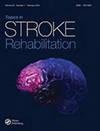铰接式踝足矫形器与家庭特定任务训练相结合可改善中风患者的功能活动能力:随机临床试验。
IF 2.2
4区 医学
Q1 REHABILITATION
引用次数: 0
摘要
引言我们比较了固定式和铰接式踝足矫形器(AFO)在家庭移动任务中的应用,以评估短期移动能力、动态平衡、生活质量、焦虑/抑郁、残疾程度、中风严重程度、自主性、人体功能和患者满意度。参与者被随机分为两组:固定式(24 人)和铰接式(23 人)AFOs。AFO 是定制的,两组患者都进行了为期四周的居家移动训练,每周五天。主要结果指标包括平衡和移动能力的变化,评估方法包括蒂内蒂以表现为导向的移动能力评估(POMA)、定时起床和走动(TUG)测试以及功能性行走类别(FAC)。次要结果包括生活质量、焦虑/抑郁、残疾、中风严重程度、自主性、人体功能和患者满意度。结果在组间比较中,调整年龄、性别、中风严重程度和溶栓因素后,铰接式 AFO 组在 TUG 测试中表现更好(P = 0.020; d = 0.93)、POMA-Gait(p = 0.001; d = 0.53)、POMA-Total(p = 0.048; d = 0.98)和 FAC(p = 0.003; d = 1.03)的表现均优于固定 AFO 组。此外,两组在人体功能(使用器械走动)方面也存在明显差异(p = 0.047;d = 92)。本文章由计算机程序翻译,如有差异,请以英文原文为准。
Articulated ankle-foot orthoses associated with home-based task-specific training improve functional mobility in patients with stroke: a randomized clinical trial.
INTRODUCTION
We compared fixed and articulated ankle-foot orthoses (AFOs) in home-based mobility tasks to assess short-term mobility, dynamic balance, quality of life, anxiety/depression, disability level, stroke severity, autonomy, human functioning, and patient satisfaction.
METHODS
This was a two-arm, parallel-group, randomized controlled trial with concealed allocation, assessor blinding, and a complete case analysis involving patients with chronic stroke. The participants were randomized into two groups: fixed (n = 24) and articulated (n = 23) AFOs. The AFOs were custom-fabricated, and both groups performed four-week home-based mobility tasks five days weekly. Primary outcome measures included changes in balance and mobility assessed using the Tinetti Performance-Oriented Mobility Assessment (POMA), Timed Up and Go (TUG) test, and Functional Ambulation Category (FAC). Secondary outcomes included quality of life, anxiety/depression, disability, stroke severity, autonomy, human functioning, and patient satisfaction.
RESULTS
In a between-group comparison, after adjusting for age, sex, stroke severity, and thrombolysis, the articulated AFO group showed better performance in the TUG test (p = 0.020; d = 0.93), POMA-Gait (p = 0.001; d = 0.53), POMA-Total (p = 0.048; d = 0.98), and FAC (p = 0.003; d = 1.03) than the fixed AFO group. Moreover, significant difference was noted in human functioning (moving around using equipment)between the groups (p = 0.047; d = 92).
CONCLUSION
A program involving home-based mobility tasks and articulated AFOs improved functional mobility after stroke.
求助全文
通过发布文献求助,成功后即可免费获取论文全文。
去求助
来源期刊

Topics in Stroke Rehabilitation
医学-康复医学
CiteScore
5.10
自引率
4.50%
发文量
57
审稿时长
6-12 weeks
期刊介绍:
Topics in Stroke Rehabilitation is the leading journal devoted to the study and dissemination of interdisciplinary, evidence-based, clinical information related to stroke rehabilitation. The journal’s scope covers physical medicine and rehabilitation, neurology, neurorehabilitation, neural engineering and therapeutics, neuropsychology and cognition, optimization of the rehabilitation system, robotics and biomechanics, pain management, nursing, physical therapy, cardiopulmonary fitness, mobility, occupational therapy, speech pathology and communication. There is a particular focus on stroke recovery, improving rehabilitation outcomes, quality of life, activities of daily living, motor control, family and care givers, and community issues.
The journal reviews and reports clinical practices, clinical trials, state-of-the-art concepts, and new developments in stroke research and patient care. Both primary research papers, reviews of existing literature, and invited editorials, are included. Sharply-focused, single-issue topics, and the latest in clinical research, provide in-depth knowledge.
 求助内容:
求助内容: 应助结果提醒方式:
应助结果提醒方式:


